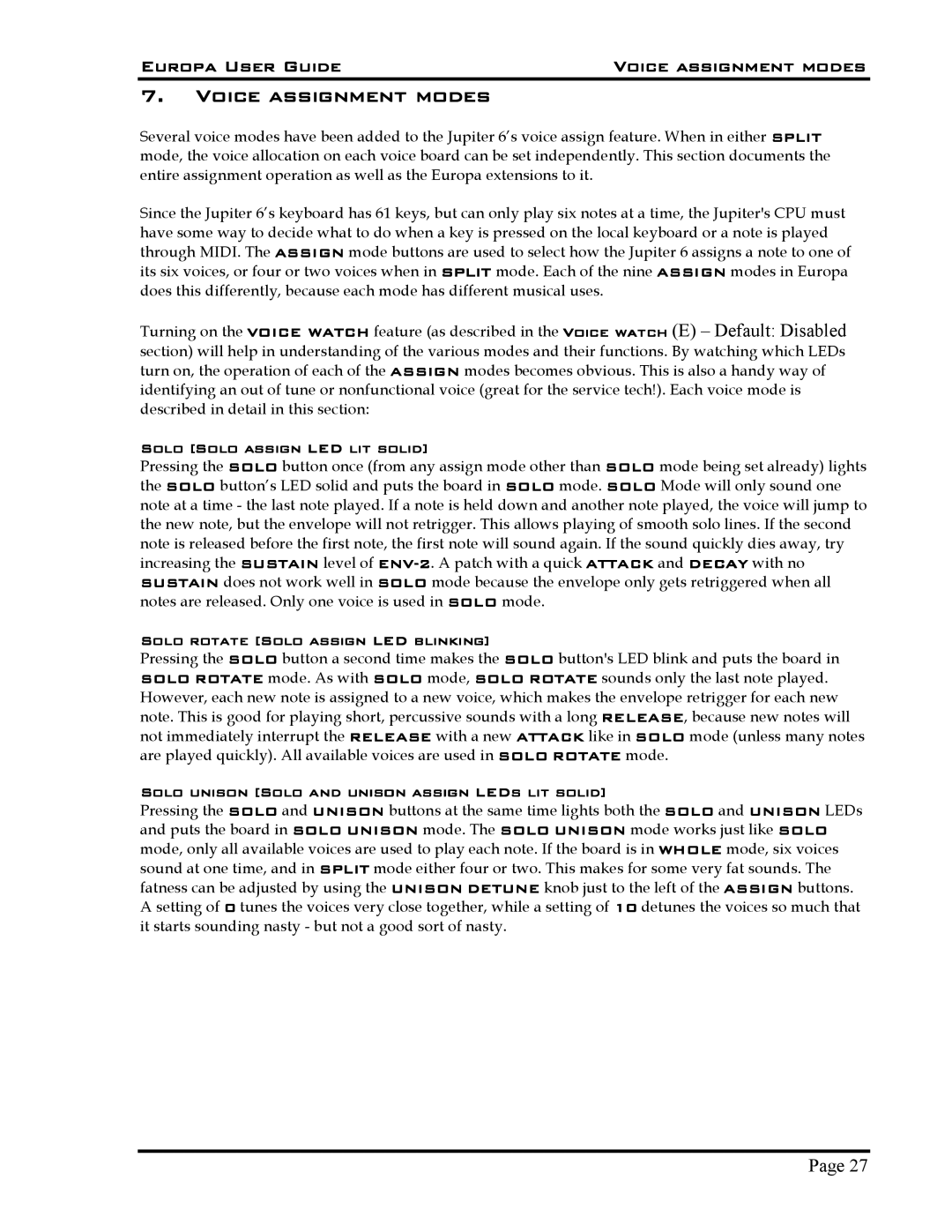Europa User Guide | Voice assignment modes |
7.Voice assignment modes
Several voice modes have been added to the Jupiter 6’s voice assign feature. When in either SPLIT mode, the voice allocation on each voice board can be set independently. This section documents the entire assignment operation as well as the Europa extensions to it.
Since the Jupiter 6’s keyboard has 61 keys, but can only play six notes at a time, the Jupiter's CPU must have some way to decide what to do when a key is pressed on the local keyboard or a note is played through MIDI. The ASSIGN mode buttons are used to select how the Jupiter 6 assigns a note to one of its six voices, or four or two voices when in split mode. Each of the nine ASSIGN modes in Europa does this differently, because each mode has different musical uses.
Turning on the VOICE WATCH feature (as described in the Voice watch (E) – Default: Disabled section) will help in understanding of the various modes and their functions. By watching which LEDs turn on, the operation of each of the ASSIGN modes becomes obvious. This is also a handy way of identifying an out of tune or nonfunctional voice (great for the service tech!). Each voice mode is described in detail in this section:
Solo [Solo assign LED lit solid]
Pressing the SOLO button once (from any assign mode other than SOLO mode being set already) lights the SOLO button’s LED solid and puts the board in SOLO mode. SOLO Mode will only sound one note at a time - the last note played. If a note is held down and another note played, the voice will jump to the new note, but the envelope will not retrigger. This allows playing of smooth solo lines. If the second note is released before the first note, the first note will sound again. If the sound quickly dies away, try increasing the SUSTAIN level of
Solo rotate [Solo assign LED blinking]
Pressing the SOLO button a second time makes the SOLO button's LED blink and puts the board in SOLO ROTATE mode. As with SOLO mode, SOLO ROTATE sounds only the last note played. However, each new note is assigned to a new voice, which makes the envelope retrigger for each new note. This is good for playing short, percussive sounds with a long RELEASE, because new notes will not immediately interrupt the RELEASE with a new ATTACK like in SOLO mode (unless many notes are played quickly). All available voices are used in SOLO ROTATE mode.
Solo unison [Solo and unison assign LEDs lit solid]
Pressing the SOLO and UNISON buttons at the same time lights both the SOLO and UNISON LEDs and puts the board in SOLO UNISON mode. The SOLO UNISON mode works just like SOLO mode, only all available voices are used to play each note. If the board is in WHOLE mode, six voices sound at one time, and in SPLIT mode either four or two. This makes for some very fat sounds. The fatness can be adjusted by using the UNISON DETUNE knob just to the left of the ASSIGN buttons. A setting of 0 tunes the voices very close together, while a setting of 10 detunes the voices so much that it starts sounding nasty - but not a good sort of nasty.
Page 27
